Raphael Madonnas on Stamps
Raphael Madonnas on Stamps
– Father Johann Roten, S.M.
Raphael is one of the most famous Madonna painters. He painted so many that his biography as a painter can be retraced and illustrated thanks to those outstanding artistic representations of Our Lady. The following is an attempt to present Raphael through his Madonnas, or at least a good number of them. Raphael's Madonnas are popular topics for Christmas stamps. Until 1991, Raphael's Madonnas were pictured on 298 stamps (or blocks of stamps) in seventy-five countries. Among the most popular we have:
Madonna del Gran'Duca 23
Sistine Madonna 23
Madonna in the Garden ("La Belle Jardinière") 16
Madonna Ansidei 15
Madonna della Sedia (chair) 14
Madonna Aldobrandini (or Garvagh or with Carnation) 13
Madonna with Goldfinch 11
Holy Family with Lamb 11
Madonna of Folìgno 10
View by period:
FIRST PERIOD
SECOND PERIOD
THIRD PERIOD
Raphael Santi was born in Urbino/Umbria on April 6, 1483. The boy was taught by his father Giovanni Santi, an honest painter. Raphael was eleven when his father died. At age sixteen he left for Perugia. He was admitted into the school of Il Perugino, his true teacher and master. In 1502/1503 he spent fifteen months with Pinturicchio in Siena. At nineteen Raphael was still a timid, somewhat mystically inclined young painter of provincial origin and habits. His first Madonnas were young, with pouting mouth, round face and veiled head. The posture was traditional and rigid, the form at times fuzzy. Already his exceptional qualities of simplicity, grace and harmony in color and composition could be noted. His admiration went to Fra Angelico whose Madonnas seemed to escape gravity. He emulated his master Il Perugino but already his own genius transpired.
1. La Madonna Solly (with the Thistlefinch)
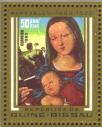
ar. 1500
Oil on board (56 x 36 cm)
Perugia
Very young Madonna, almost childlike, reading from a book. The face has not yet the oval shape of Florentine Madonnas. The painting exudes a certain austerity and simplicity. Il Perugino's influence is easily detectable.
Museum of Berlin (acquired with the Solly collection), #141
Guiné-Bissau, em. 1983.
2. Madonna Connestabile
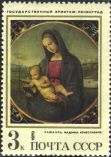
1502-1503
Oil on panel (18 cm diameter)
Perugia
Considered to be one of the greatest gems of miniature paintings, this Madonna was painted for Alfonso di Diamenti, a friend of Raphael's. The Virgin stands in open air reading, while the child touches and looks into the same book. Mary is dressed in traditional Marian colors: red tunic and blue mantle with hood over her head. The child's playfulness reflects ease and security in his mother's arms. The pretty landscape in the background suggests the passage from winter to spring.
The painting was sold by Count Scipione Connestabile to the Empress of Russia in 1871.
Hermitage, St. Petersburg
USSR, em. 1970
3. Madonna of Diotalevi
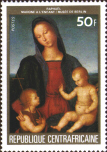
ca. 1503-1504
Oil on panel (69 x 50 cm)
Perugia
Assigned to Perugino, this painting is probably by Raphael. The board has been injured and the blues have degenerated. More refined (long neck and oval face) than the Solly Madonna, it is part of the Perugino Period. The Virgin supports the infant sitting on her lap, her right hand rests on the shoulder of John the Baptist. Christ's right hand is raised in benediction; John receives the blessing in pious posture. Mary's face shows arched eyelids and the pursed mouth peculiar to Raphael. Its expression is one of motherly affection for both infants, a resigned presentiment of things to come, and a shade of the typical Umbrian "smorfia."
Museum of Berlin (purchased in 1842 from Marquis Diotalevi).
Republic of Central Africa, em. 1984.
4. Madonna of the Pomegranate

ar. 1504
Drawing with black pencil (418 x 298 cm)
early Florentine work
Possibly a cartoon for the Connestabile Madonna, this drawing is of high precision, technique and balance. The half-length Madonna and child concentrate in posture and look on the pomegranate held by both child and mother. Echoes of Della Robbia can be seen in this drawing, especially in the sweet thoughtfulness of the Madonna.
Collection Albertina, Vienna
Austria, em. 1969
5. Coronation of the Virgin

ar. 1501
oil on canvas (267 x 163 cm)
Perugia
A large altarpiece, the Coronation was apparently executed for Alessandro di Simone degli Oddi (for Magdalene Oddi, according to some). The painting has two parts: the coronation of Our Lady in the upper part and the apostles gathered around the empty tomb of Mary, and looking heavenward, in the lower section. The tableau rests on the predella which comprises three small rectangular paintings of 50 x 27 cm each. They represent from left to right: Annunciation, Adoration of the Magi and Presentation in the Temple. The adoration in the center is a very colorful and lively scene. It is flanked by two sober and almost hieratic representations of Annunciation and Presentation due to vertical composition, depth and symmetry. The painting is credited with extraordinary artistic diligence. It makes allusions to the lofty Florentine tradition, the vigor of Leonardo, and the majesty of della Robbia. The quality of light is such that the painting appears a magnificent high relief.
Vatican Pinacoteca
Lesotho, em. 1987
Adoration of the Magi
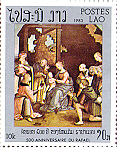
ar. 1502/03
This feature of the Madonna is part of the large Oddi altarpiece mentioned under #5 (Coronation of the Virgin)
Vatican Postal Service, em. 1959
6. Crucifixion
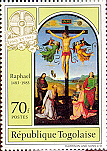
ar. 1502
oil on panel (165 x 280 cm)
Città di Castello
Christ on the cross–surrounded by two hovering angels collecting the precious blood oozing from the wounds of his hands–dominates a group of four: on his right the Virgin and St. Jerome; on his left St. John the Evangelist and Mary Magdalene. This scene, composed in strict symmetry and still marked by Perugino, is set against a vast and sunlit landscape. This altarpiece–often called Mond Crucifixion from the name of its owner–was commissioned for the Gavari Chapel in San Domenico. The unity of tone characteristic of Perugino is brightened by the lively Florentine color scheme. Of the four figures at the foot of the cross two are kneeling: St. Jerome and St. Mary Magdalene. Their posture is that of penitents (St. Jerome since the fifteenth century) whereas Mary and John are pictured standing, posing as participants in Christ's passion and disciples of the Redemption.
London, National Gallery
Republic of Togo, em. 1983 (on the occasion of the fifth centenary of Raphael's birth)
7. Marriage of the Virgin

1504
oil on board (117 x 170 cm)
Città di Castello
Still in Perugino's studio this far-famed painting marks the end of Raphael's early period and works executed in Città di Castello. Taking stock of his early Florentine experiences and the apprenticeship at Perugino's hand, he now finds his own sense and expression of painterly poetry. The Sposalizio (Marriage) had been ordered for the Church of San Francesco. It is dated (1504) and is signed (Raphael Urbinas). There are two elements that constitute this painting: the temple (upper half) and the scene depicting the marriage ceremony (lower part and foreground). Perspective and depth lend unity to these elements; symmetry marks the whole atmosphere with nobility. Both Mary and Joseph are attended by five young women or men, the young men carrying rods. Alone, the rod of Joseph budded, sign of his election as bridegroom. One of the rejected suitors breaks his rod. Although of sober and strict composition, the painting exudes grace contained and expressed in the posture and movement of the people present, in particular that of Mary and Joseph. Garbed in the classical colors of red and blue, the Virgin enters marriage serenely and gracefully.
Brera Gallery, Milan
Antigua and Barbuda, em. 1989
In late 1504 Raphael moved to Florence where the encounter with Leonardo occurred and so vitally affected his style. After the mastery of the perspective it was then the study of luminous and graphic dynamics that challenged his genius. How to include the element of color in the totality of the image? Refining his sense of color, Raphael attempted to match color and light; marrying light and shadow, he created the impression of movement and action. This is what Vasari calls the "dolcezza ne' colori unita," the sweet harmony of colors. The conquest of a new and vibrating beauty characterizes this period. Raphael produced during this short period more than twenty Madonna paintings.

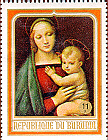
1504-1505
Oil on panel (84 x 55 cm)
Florence
This is the first picture painted in Florence. Raphael went there in 1504. The Madonna of the Gran'Duca is one of the most beautiful. It has been reproduced countless times and featured on stamps at least twenty-three times.
The Virgin's features are calm and serene but radiant and almost translucent, contrasting with the chubby earthiness of the infant Jesus. "Although slightly and very simply painted, especially in the nude parts, this picture excels all Raphael's previous Madonnas in the charm of a profound feeling" (Kugler). Some authors see in the Gran'Duca Madonna a resemblance (and influence) of da Vinci's Joconda ... smiling less mysteriously!
The name does not refer to the person who commissioned this Madonna but who owned it at one time. It is said to have belonged to Carlo Dolici (1616-1686) before it eventually came into the possession of Grand Duke Ferdinand III of Habsburg in 1799. The painting became his faithful companion; he carried it with him wherever he went. This is the reason why the picture is also called "Madonna del Viaggio" (of the journey).
La Madonna del Gran'Duca is in the Pitti Gallery in Florence.
San Marino (Italy), em. 1983

ar. 1504-1506
oil on panel
210 x 148 cm
Perugia
Also called "Blenheim Madonna" this altarpiece was painted for the Servite Church San Fiorenzo where it embellished the San Niccolò di Bari chapel. It was commissioned by the family of Filippo di Simoni Ansidei ... whence its name. The Ansidei Madonna was purchased by the third Duke of Marlborough in 1764 for his castle of Blenheim. It became the property of the British government in 1885 and is now in the National Gallery in London.
Mary enthroned on an elevated pedestal is flanked by two saints: St. John the Baptist to her right pointing with his right hand to Jesus, and St. Nicholas of Bari on Mary's left side reading the Book. So does Mary! She looks down at the book that lies on the folds of her blue mantle draped over her left knee. The fingers of her left hand are curved over the pages holding the book open or pointing to a particular passage. Mary's right hand rests on Jesus' shoulder. He sits on her right knee looking pensively at the book. He holds in his left hand the blue and gold striped sash which winds around his arm and body. Mary's head is framed with her mantle. The face is that of a youthful mother, dignified and imposing in all her gracefulness. She wears a red dress. The inscription over her head says in Latin: Salve Mater Christi.
Anguilla, em. 1971
10. Madonna of Cowper

1505
painted on wood
58 x 43 cm.
Florence
This Madonna painting of 1505 was purchased by Lord Cowper around 1870 when he was British Ambassador to Florence. A copy exists in the Lombardi collection in Florence.
The Virgin is seated in an open-air setting; her posture and countenance are less aristocratic than those of the Gran'Duca Madonna. She holds the naked Child with her left hand; he rests one foot on his mother's right hand, and places his arms around her neck. There is a touch of sadness in both mother and child. In the distance is a church with a dome and campanile. The execution is simple and easy, and da Vinci's influence is detectable in the drawing of the hands.
National Gallery, Washington
Penrhyn, Northern Cook Islands, em. 1983
11. Madonna of Orleans
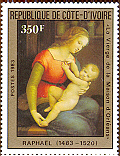
1506
painted on wood
30 x 22 cm.
Florence
Painted in 1506 and probably executed for Guidobaldo of Montefeltro, this little painting, perfectly preserved, passed through many hands. It was once in the possession of the brother of Louis XIV of France, then in the Orleans Gallery.
The Madonna sits on a cushioned chair in a small room adorned with a shelf on which pots and vases are arranged. Mary's hair is twisted with a subtle veil; she is dressed in customary blue and red. The child rests half recumbent on his mother's lap. He hangs on with both hands to the hem of her dress. The expression of the mother is characterized as one of "serene melancholy." The painting is remarkable for the transparent quality of the flesh parts and the subdued glow of the whole surface.
Musée Condé, Chantilly (France)
République de Côte-d'Ivoire, em. 1983
12. Madonna di Sant' Antonio
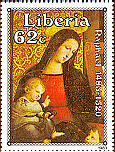
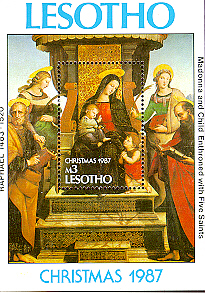
1505 (1507-1508)
oil painting on wood
169 x 139 cm
Florence
Part of a large composition, this painting was executed for the nuns of Sant' Antonio of Padua for their convent in Padua. Datation varies according to different art historians (Morelli, Vasari) between 1505 and 1508. The painting was sold to A. Bigazzini, passed into the hands of the Colonna family , was lent in 1886 to the South Kensington Museum and is now in the Metropolitan Museum in New York.
There are seven figures in this painting which shows resemblance to the Madonna del Baldacchino. The Virgin is seated on a throne holding the blessing Christchild on her right knee and pressing John the Baptist forward with her left hand to receive Christ's blessing. To Mary's left we have St. Catherine and St. Peter; to her right we see St. Margaret and St. Paul. In the lunette above this central "altarpiece" is the Almighty with two adoring angels. The three scenes of Christ's life of the predella are now dispersed.
Vasari comments as follows: "To the Virgin the master has given the most lovely features and the most graceful attitudes. The whole work is, without doubt, very admirable; it is full of devout feeling. It is very highly commended by all painters likewise."
Liberia, em. 1983 (and Lesotho, em. 1987
13. Madonna di Terranuova

ca. 1505
oil on wood panel (tondo = circular)
87 cm. diam.
Florence
Also called "Madonna coi bambini" (with the children), this painting was originally in the possession of the Duke of Terranuova. It was purchased in 1854 by Frederick William IV of Prussia and is now in the Berlin Staatsmuseum.
The Virgin is represented seated in a rocky landscape with the child in her lap, who together with the Baptist, is holding a scroll. A third child is leaning on the Virgin's knee, gazing at the infant savior. The boy is probably intended to represent James the Less.
Art historians see in this Madonna the influence of Michelangelo's Madonna now in the Uffizi. The contrast between Mary and the background landscape is a masterpiece of pictorial arrangement.
British Virgin Islands, em. 1983
14. Madonna in the Meadow
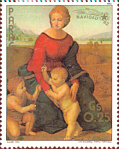
1505/06
Oil painting on wood
113 x 88 cm
Called "Madonna Verde" or "Belvedere Madonna," this painting was a gift to Raphael's friend Taddeo Taddei. It was sold to the Austrian Imperial family and transferred, in 1773, to the Imperial Collection at the Belvedere Gallery in Vienna.
The Virgin is seated on an elevation of ground in a beautiful landscape. In the background there is a rendering of the Trasimenian Lake. With both hands she supports the Child who stands before her, her head inclined towards St. John who, kneeling at the side, offers a cross to his companion.
The composition is in the shape of a pyramid, probably inspired by Leonardo's Saint Ann Threesome. The picture is of tender sweetness, the deep brownish tones of drapery and landscape still another concession to Raphael's model and inspirator.
Paraguay, em. 1982
15. Madonna Tempi

1506/07
Oil on wood
75 x 51cm
This representation of mother and child was painted for the family Tempi. The Virgin is represented standing, but seen only half-length. Mary holds the baby in her arms, his face rests against hers. We are dealing here with a typical example of the Eleousa type or Virgin of tenderness.
This is what an art historian has to say about this painting: "Raphael, in reference to the endearments between the mother and child, has always observed a degree of reserve, respect, and modesty, which contributes ... to manifest the character of holiness which the subject requires." (Karoly, 68) Madonna di Casa Tempi is a fine example of the victory of Florentine over Tuscan style. Type, mould of face and drapery are pure Florentine.
The painting has suffered from unskillful restoration. It was purchased in 1820 by King Ludwig of Bavaria.
Alte Pinakothek, Munich
Republica de Guinea Ecuatorial, em. 1971
16. Madonna Canigiani (Holy Family)
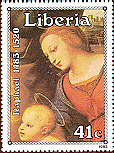
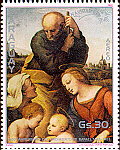
1506-1507
oil on panel
107 x 77 cm
Madonna Canigiani, after the Florentine family of the Canigianis, is in fact a representation of the Holy Family. There are five figures in this picture, arranged in a pyramidal system. At the apex there is Joseph, leaning on his staff. Below, facing each other in a sitting position are Elisabeth and Mary, and, between them, John and Jesus. Jesus holds in hand a scroll upon which are written the words: Ecce Agnus Dei. The attention of the three adults is directed toward the two toddlers. According to Vasari, "all appear to be astonished at the manner in which the two cousins treat each other at an age so tender." Mary holds a book in her hand in which she had been reading.
Alte Pinakothek, Munich
Liberia, em. 1983
17. The Entombment
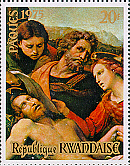
1506-1507
oil on panel
184 x 176 cm
This panel was executed for the Church of San Fernandino in Perugia. It had been ordered by donna Atalanta Baglioni in memory of her son, victim of local feuds. The painting was purchased by Pope Paul V (1565) for the Borghese Collection (Villa Borghese, since 1894), whereas the tympan which goes with the painting and represents God the Father (with uplifted hands) is still in Perugia.
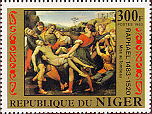
Villa Borghese, Rome
République Rwandaise, em. 1975 (Easter)
Here is what Vasari says of this "justly celebrated work":
"In this most divine picture there is a dead Christ, whom they are bearing to the sepulchre, the body painted with so much care and freshness that it appears to have been only just completed. When occupied with the composition of this work, Raphael had imagined to himself all the grief and pain with which the nearest and most affectionate relatives see borne to the tomb the corpse of one who has been most dear to them, and on whom has, in truth, depended all the honour and welfare of the entire family. Our Lady is seen to be sinking, insensible, and the heads of all the weeping figures are exceedingly graceful; that of San Giovanni most particularly; his hands are clasped together, and he bends his head with an expression which cannot but move the hardest heart to compassion. Truly may we say that whoever shall consider the diligence and love, the art and grace exhibited in this work, has good reason to feel astonishment, and it does indeed awaken admiration in all who behold it, not only for the expression of the heads, but also for the beauty of the draperies, and in short for the perfection of excellence which it displays in all its parts."
18. Madonna with the Goldfinch
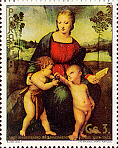
15061507
oil on wood
107 x 77 cm
Called in the original Italian "Madonna del Cardellino," in French "Vierge au Chardonneret" this painting was realized by Raphael in about 1506 for his friend Lorenzo Nasi as a wedding present for his bride. The 1548 Monte San Giorgio landslide destroyed Nasi's house and Raphael's painting was broken into many pieces. Battista, son of Lorenzo, put it together with much skill.
The goldfinch presented by St. John Baptist to Jesus gives the name to the picture. The virgin is sitting in a meadow planted with elegantly brushed trees, and, in the background, rolling hills and the skyline of Florence lend depth to the painting. Mary holds in her left hand an open book. Between her knees stands Jesus fondling with his right hand the goldfinch offered by St. John. The Virgin's right hand rests on his shoulder in grateful acknowledgment of his eagerness to please her son. The little bird may be viewed as symbol of Christ's passion and death to come, since the red streaks among the goldfinch's feathers suggest blood. Mary's posture and attitude have a similarly symbolic value. Contemplating book, nature, and Jesus' gesture, Mary attracts the attention of the onlooker to the manifold origin of God's wisdom and revelation: his creation, the revelation of his love in words (book) and the Word (Jesus), and the apex of his loving deeds in the event of Redemption (goldfinch).
Uffizi Gallery, Florence
Paraguay, em. 1983
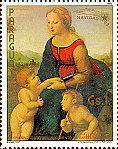
1507
oil on wood
122 x 80 cm
Signed on the edge of the Virgin's mantle "Raphael Urb" and "MDVII," this painting is more commonly known under the title "La belle jardinière," probably because it was purchased by order of François I and eventually bequeathed to the Louvre. The Virgin is sitting amongst flowering shrubs and plants in an attractive landscape whence the name of the painting. It is said that within two years Raphael painted this subject three times (see, for example, "Madonna in the Meadow").
Again the subtle and fluctuating harmony makes for much of the aesthetic quality of this painting. As so often in Raphael's madonnas, the vividness of light and the brilliance of colors overcome and dominate the massive shadow cast by Mary's dark blue mantle.
Louvre, Paris
Paraguay, em. 1982
20. Madonna del Baldacchino
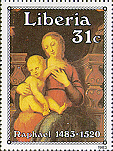
1508
oil on wood
276 x 224 cm
This is one of the unfinished Raphael Madonnas; it received and deserved its name 'del baldacchino," meaning "of the canopy," when about 1697 Agostino Cassana added the canopy. The original then was placed in the Pitti Museum in Florence, whereas a copy was substituted for the original in the cathedral of Pescia, the native place of Msgr. B. Turrini, the former owner. Raphael had left this painting unfinished, when in 1508 he went to Rome.
Mary is seated on a throne holding the child on her knee. He gazes at St. Peter, one of four saints surrounding the throne. Next to him we have St. Bernard, patron of monastic learning and wisdom. On the Madonna's right side are St. James the Less, hands resting on a sturdy staff, and St. Augustine. At the foot of the throne and hovering right and left of the canopy, four little angels.
Palazzo Pitti
Liberia, em. 1983
21. Madonna Esterhazy
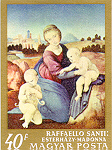
1508
oil on wood
28 x 22 cm
Only a small picture, this representation of the Madonna is probably one of a series of "tableaux de salon" sketched or outlined by Raphael but finished by some of his students. Painted between 1508-1513 it was given by Pope Clement XI (1700-1721) to Empress Elizabeth of Austria. She donated it to Kaunitz, from whom it passed to the Esterhazy family (Hungary).
The motif is familiar presenting Mary surrounded by Jesus and John the Baptist. We see Mary in a kneeling position. She holds the child who is sitting on a rock. The holy toddler points with outstretched arm to John who turns his back on Mother and Child while reading a scroll bearing the words Ecce Agnus Dei. In the background sitting on top of a knoll, we can see the silhouette of a walled city with towers.
In spite of the overall gentle harmony of the picture, there is prophetic drama involved. St. John anticipates Christ's passion ominously lying in the future, hiding it literally from Mother and Christ Child (turning his back on them). However, the Christ Child himself "knows" already and makes it known with his outstretched arm.
Esterhazy Gallery at Pesth (Budapest)
Hungary, em. 1984
22. Madonna Cowper
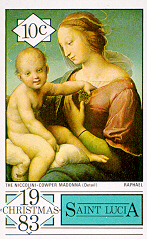
1508
oil on wood
68x46 cm.
This is the larger and latter of the two Cowper Raphael Madonnas, sometimes called the "Panshanger Madonna." On the border of the Virgin's garment near her throat the artist's stamp can be read (MCVIII.R.U.Pin.). The child is seated on a pillow in the Virgin's lap, his left hand pushed into her bodice, hers raised and near his. Art historians see in this painting a reaction against overwrought tenderness and Umbrian piety. The baby's posture and expression, in particular, is an "unconditional appeal to the grace of nature unadorned." For Morelli the Madonna Cowper (1508) is "perhaps the most lovely of all of Raphael's Madonnas."
National Gallery, Washington
Saint Lucia, em. 1983
23. Madonna Colonna
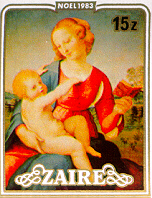
ca. 1507
oil on wood
77x56 cm.
The painting belonged to the Salviati family of Florence and passed by inheritance to that of the Colonna. In 1828 it was purchased by the Prussian government.
This is not an authentic Raphael. Some historians agree that the unfinished painting was left behind in Florence to be completed by Ridolfo Ghirlandaio. The resemblance with the Madonna Cowper of 1508 is striking. Even so, it remained unfinished lacking of shade and too bright in coloring.
The pose of the Virgin is serene and playful holding in her left hand a missal and contemplating the efforts of her child to rise. This Madonna shows resemblance with Raphael's sketch in the Albertina (Vienna) whereas the child is like that of the Orleans Madonna.
Museum of Berlin
Zaire, em. 1983
The third and last period of Raphaël's work and life coincides with his Roman sojourn. Called and commissioned by Pope Julius II, Raphaël transfered to Rome at the end of 1508. Here he decorated the three so-called stanzas at the Vatican. These wall and ceiling frescoes reflected a wide range of historical, religious, and mythological motifs. The Stanza della Segnatura (1509-1511) illustrates the age-old discussion between philosophy and theology in the "Disputa" and the "School of Athens." In the second stanza, called "Stanza d'Eliodoro" (1511-1514), he pictured the "Expulsion of Heliodor." The decoration of the "Sala del Incendio," the third stanza, was the work mainly of his disciples, Raphaël having been the inspirator and chief designer. The same applies to the decoration of the Vatican Loggias, and of such well-known paintings as The Triumph of Galathea (1514) and Amor and Psyche (1516-1517), both at the Villa Farnesina. At the death of Bramante in 1514, Raphaël is entrusted with the rebuilding plans for St. Peter. During this period, he was also in charge of the excavation, maintenance, and restoration of Roman and Vatican monuments. Not least, the rich and powerful of the day continued to commission Raphaël with the embellishment of their palaces and churches. Overworked and exhausted, Raphaël died at age thirty-seven, on April 6, 1520.
During this last period, Raphaël's Madonnas developed a new characteristic. They appear to be more powerful, and even dramatic, without losing the more fragile loveliness of the Florentine period. Some art critics speak of these Madonnas as representatives of absolute beauty.

ca. 1510
Oil on panel
38x33 cm.
National Gallery, Berlin
Cayman Islands
This is an authentic Raphael from around 1510. It was purchased by the Aldobrandini family and collection and eventually was acquired in 1865 by the National Gallery in London.
The painting's composition is pyramidal, symmetric and triangular. The Virgin is seated on a bench, her face aglow in light contrasting with the dark pillar in the background. In her right hand she holds her blue mantle in a gesture to protect and cover the infant Jesus. Her left hand rests on St. John's shoulder. The fame of the painting is the red carnation which Jesus offers to John. The Virgin encourages John to claim the carnation by gently pressing his shoulder. John is stretching his left hand to take it.
25. Madonna della Tenda

ca. 1514
Oil on panel
66x51 cm.
Old Pinakothek, Munich
The stretched green curtain (tenda) in the back of Mother, Child Jesus and John, gave the painting its name and covers much of the background of the painting. The authenticity is doubtful, the concept being by Raphael but executed probably by one of his disciples or friends. The painting was at one time in Madrid (Escorial), then Paris and London, and finally in 1814 to Munich. There exists a replica of this painting by Perino del Baga, a Florentine painter, in Turin.
The Virgin is seated with her face in profile, holding with her right arm the infant Jesus who is lying on her lap. Jesus seems to be listening to John whose face – expressing respect – is next to that of Jesus. The Virgin wears a veil over her forehead upon which a red cloth is twisted.
Guine-Bissau, em. 1983
26. Madonna della Torre

1512
Oil on canvas
73x64 cm.
Private collection, London
Cayman Islands
Painted in 1512, this painting may not be entirely by Raphael. It goes also by the name of "Madonna with the Standing Child" and "Roger's Madonna." In the back, a tower-shaped building can be seen, which allowed for still another appellation of the painting.
The Virgin stands behind a parapet on which the Child rests one foot, with his arms around her neck. Here is what an art historian has to say: "...the Virgin gazes at the boy with a delicious fondness, whilst he looks out of the picture with a smile, as if unconscious of all but the joy of the moment."
Charming detail: Mary's left hand clasps the boy's left foot while her right hand rests on his waist.
27. Madonna di Casa d'Alba

1511
Oil on canvas
98 cm. diameter
National Gallery, Washington
Reputed as one of Raphael's "most careful works and of most exquisite finish," this painting is part of the Roman period. It passed at some time (eighteenth century) into the gallery of the Duke of Alba in Madrid, and got into the hands of the Tsar of Russia in 1836.
The Virgin is seated in a meadow of wild flowers and violets. Her back rests against the trunk of an oak tree. The left hand holds a book half closed over her finger, the other arm rests on the shoulder of Saint John. He clings to her while climbing into her lap and gazing at the cross held by Jesus, while John looks eagerly at Mother and Son.
Replicas of this painting exist in Genoa under the title of "Madonna della Rovere" (oak), another one in the Palazzo della Torre, Ravenna.
Paraguay, em. 1982
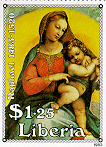
1511
Oil on canvas
300x198 cm.
Vatican Gallery, Rome
Painted in Rome in 1512, this painting was ordered by Sigismondo Conti of Foligno who was private secretary to Pope Julius II and who had the painting placed on the high altar of the Franciscan church in Ara Coeli, Rome. It was to be a votive offering to Mary for her protection against lightning or the fall of a meteor.
The Madonna holding the Child is seated upon the clouds above the distant city of Foligno. She is surrounded by angels. Below her we have two groups of the saints: on the left St. John the Baptist and St. Francis, on the right St. Jerome and Sigismond Conti, the donor. St. Sigismond is the patron saint of the donor and also the saint to whom the Jeronimite convent near Cremona was dedicated. St. Jerome begs the protection of the Virgin for the donor, who kneels in front of him. Between the two groups stands a little cherub holding in his hands a tablet. According to art experts, this painting is particularly remarkable for "the deeper golden tint which was never apparent" in Raphael's earlier works.
Liberia, em. 1983
29. Madonna Bridgewater

1511
oil on canvas
90 x 60 cm
Bridgewater House, London
Cayman Islands
The Madonna Bridgewater, also known as 'La Plus Belle des Vierges', was not entirely painted by Raphael and transferred from wood to canvas. From the Seignelay Collection it passed to the Orleans gallery and from there into the possession of the Duke of Bridgewater. There are several copies of this painting in different collections.
The Virgin is presented in a sitting position within a confined dark space. The child is stretched across her lap, his head rests on Mary's right shoulder, his face turned toward his mother.
Burckhard says the following of this painting: "The infinite grace of the picture, by where it takes a dreamy hold on the imagination of the spectator, is owing less to the beautiful forms and features than to the exceedingly perfect lines, to the sweep of the movement of the mother and child, to the disposition of the light."
30. Madonna of the Diadem
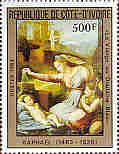
1512
Oil on Panel
70x50 cm
Museum of the Louvre, Paris
Also called "Madonna with the Veil" and much injured by repainting, this genre is known under the term "silentium" or "Vierge au silence."
The virgin kneeling on the ground lifts the veil from the face of the slumbering child. She wants St. John to see Jesus. St. John is kneeling, his hands folded in prayer and his arms clasped around the reed cross. Mary wears a blue diadem to which a flowing yellow veil and a muslin cloth, which clings to her shoulders and arms, are attached. The skyline in the back is Roman. It shows the Pantheon lying in the nook of the Tiber Valley. The vista is partially blocked out by an ensemble of ruins.
It is said that this painting, divided in two halves, at one time covered two casks at Pescia where it was found by an amateur who had it repaired by so skillful an artist that no trace of the joining can be seen.
Ivory Coast, em. 1983
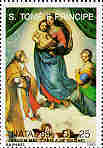
1519
Oil on Canvas
265x196 cm
Dresden Gallery, Germany
Better known under the name of "Sistine Madonna," it is the last Madonna painting painted by Raphel (1519). It was painted for the monastery of San Sisto in Piacenza, whence its name. Purchased by Augustus II of Saxony (1753), it was "abducted" by Napolean but returned soon after and restored in 1827. It is now in the Dresden Gallery.
Mary with Child stands on a globe partially covered by clouds, her veil billowing in an imaginary draft coming from the left side of the painting. Draperies left and right of Mary give the impression of a theatrical setting. Mother and Child are framed in contrasting fashion by the older St. Sixtus (he bears the traits of Julius II, whereas the Virgin resembles the famous Fornarina) and Saint Barbara in the splendor of youth. Mary's expression is one of lofty dignity. Her eyes – like those of her son – reflect according to one commentator "an eternity of unutterable fondness." Legend says that the two little angels were in fact two little boys who climbed up the window of Raphaels's studio and there intently gazed at the artist while he painted.
S. Tome e Principe, em. 1989
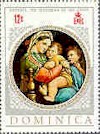
1514 appr.
oil on tondo
71 cm diameter
This painting is named after the chair (sedia) in which the Madonna is sitting. Painted between 1510 and 1514, it is of Raphael's own hand – undisputedly. Considered by many the most popular and most widely disseminated of all Raphael madonnas, it was probably painted for Pope Leo X or one of the Medici.
The Virgin holds the Infant on her lap, the glances of both mother and child are directed to an undetermined group of onlookers. St. John, as is often the case in Raphael's Madonna paintings, stands in adoration to the right of Jesus and Mary.
A pretty legend is attached to this painting which tells the story of a hermit, the beautiful daughter of a wine-dresser and Raphael.
"Centuries ago, there dwelt among the Italian hills near Rome a venerable hermit, whom the people called Father Bernardo. During a terrible storm his life was saved by Mary, the beautiful daughter of a wine-dresser, and by an old oak-tree in whose branches he had taken refuge; so he prayed to God to distinguish them in some way. Years passed away, the hermit died, and the oak-tree was converted into casks for Mary's father. One day Mary was sitting by one of these casks playing with her children, the elder of whom ran towards her with a stick made into the shape of a cross. Raphael had long been seeking a model for a picture of the Virgin and Child; just then he passed by, and seeing the group, stopped and drew them on the smooth cover of the wine cask. This he took away with him, and on it painted the Madonna della Sedia. Thus was the blessing and desire of the old hermit realized, and Mary and the oak were distinguished for all time." [Mrs. Clement, "Christian Symbols and Stories of the Saints," pp. 213-4.]
Pitti Gallery, Florence
Dominica, em.
33. Madonna del Pesce

1514-1515
oil on canvas
215 x 158 cm
Painted by Raphael in Rome 1514 - 1515, Our Lady of the Fish was destined to embellish the church of Saint Dominic in Naples. This church attracted people afflicted with diseases of the eyes. Raphael thus introduced Tobias with the fish, for Tobias had cured his father's blindness with the gall of a fish. Tobias is led to the throne of Mary and Jesus by the angel, Raphael, Tobias' guide and protector. On the right of the throne we glance at St. Jerome with a book in his hands. St. Jerome is the translator of the Book of Tobit. He is accompanied by the lion, his customary attribute. The throne with a regal Madonna holding back her infant who eagerly stretches his right arm to grasp the fish is painted against a large curtain.
This large altarpiece was taken from St. Dominic's church by the Duke of Medina, Viceroy of Spain in Naples, in 1638; it passed to the hands of Philip IV of Spain (1645) and can now be seen in the Prado/Madrid.
El Prado Gallery
Penrhyn (Northern Cook Islands), em 1987
34. Madonna del Passeggio
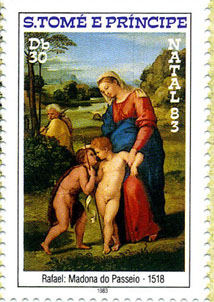
(Roman Period) 1518
Oil on wood panel
88 x 62 cm
Bridgewater House, London
The execution of this falsely-attributed painting is thought to be that of Penni, also called "Il Fattore," one of Raphael’s assistants.
Euphemistically called "Madonna of the Walk," the painting represents a scene in the Flight to Egypt. The Virgin and Child pause to greet young St. John. The Virgin holds the arm of the Christ Child with her left hand, and puts her right hand on St. John’s head. The two naked children are the expression of bucolic innocence and friendship. St. Joseph is on his way, half hidden by shrubbery and trees.
The idea is charming, the children graceful, the landscape pretty, but the overall impression leaves little place for the grand emotion produced by Raphael. There is a certain heaviness and affectation in this painting, and the drawing is in parts incorrect.
S. Tome e Principe, em. 1983
35. Madonna della Rosa
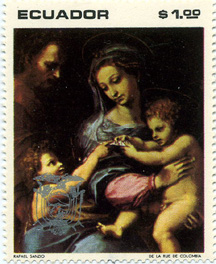
1518-1519
Oil on canvas
103 x 84 cm
Prado, Madrid
It was painted by Giulio Romano, possibly from a design by Raphael. Numerous copies were made from the original. The name stems from the rose lying at the foot of the Christ Child. He draws a scroll from the fingers of St. John, probably an allusion to his future passion. Mary’s gaze is a mixture of melancholy and serenity. Joseph, a typical background figure, is absorbed in thought.
Ecuador, em. 1983
36. Madonna della Perla
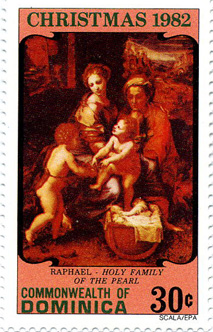
1517-1519
Oil on wood transferred to canvas
4 feet 8 ¾ inches x 3 feet 9 ¼ inches
Prado, Madrid
It takes its name from Spain's Philip IV's exclamation: "This is my pearl," when he first saw the painting. This Madonna, or better the Holy Family, was probably painted by Giulio Romano from a design by Raphael.
The painting has a long history of ownership from the Counts of Canossa and other Italian courts to that of England (Charles I) and Cromwell to the Escorial and Philip IV (1649). The figure to the right of the Virgin is St. Anne, watching intently the two children. The Madonna, relaxed and serene, puts her right hand on her mother's shoulder. St. Joseph fades into the background to the left.
Dominica, em.1982
37. Madonna del Lagarto (of the oak)
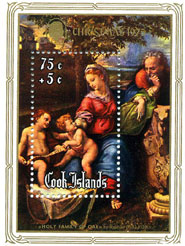
1518-1519
oil on wood
4 feet 8 3/5 x 3 feet 7 1/3
Prado, Madrid
The authenticity remains doubtful, although the cradle is signed "Raphael Pinx." Nothing is known about the history of this painting, except for the fact that Giulio Romano made a copy on which he added a lizard. (See: Madonna della lucertola, Pitti, Florence). There is also a copy of "Madonna of the Oak" at the Hermitage, St. Petersburg, attributed to Giulio Romano.
The Virgin is in classical blue and red. Her demeanor is one of tranquil pride. Her left arm rests on an antique sculpture. St. Joseph in typical pensive posture is leaning on the same piece of sculpture and watches the Christ Child and St. John. The toddler Jesus looks at his mother while taking a scroll from the Baptist. The words inscribed on the scroll are Ecce Agnus Dei.
Cook Islands, em.1975
38. Madonna of Francis I (Holy Family of the Louvre)
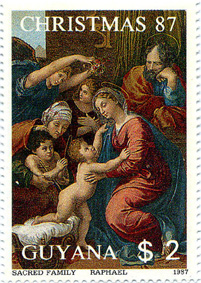
1518
Oil on wood transferred to canvas
6 feet 5 x 4 feet 3
Louvre, Paris
Considered the masterpiece of Raphael’s Holy Families, it is figured and dated on the blue mantle of the Virgin. Painted for Lorenzo de Medici as a gift to Francis I of France, it manifests the maturity of Raphael’s art in handling large scale figures, richly clad attires, and palatial architecture.
A more dramatic composition, the painting suggests a truly "moveable feast" triggered by the Christ Child rising from his cradle and received by the crouching mother. This lively group contrasts with the more static but intensely watching group of St. Elizabeth and the Baptist child. One of the two angels in the back is about to cover the Madonna with a wreath of flowers, while Joseph contemplates the scene putting his face on his hand.
Guyana, em.1987
39. Madonna dei Candelabri
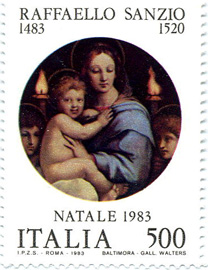
1515
Tondo
60 cm diameter
Walters Gallery, Baltimore
Also known under the name of "La Vierge aux Candelabres," this tondo ranks among the most excellent of Raphael's creations. There are two representations of this theme. The Madonna, a half-length figure, is standing. She holds the infant who is seated on a white cushion. He casts a cheerful glance at the spectator and holds on to his mother’s vestments. The central group is surrounded by two angels (heads and one hand visible) holding up flaming candelabra.
Italy, em.1983
40. Madonna dell 'Impannata
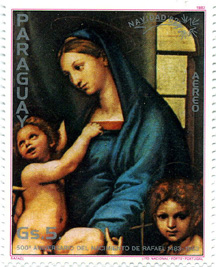
1513 appr.
Oil on wood
158 x 125 cm
Pitti Palace, Florence
The name "Impannata" designates a window covered with a linen pane. Its authenticity frequently questioned, there are drawings for it by Raphael. Some art historians attribute the execution to Giulio Romano.
The Madonna presents her son to St. Elizabeth while the younger woman behind St. Elizabeth, St. Mary Magdalene, points to St. John the Baptist, and he in turn points to Jesus. St. John is eight or nine years old. The anachronism has been explained as required by the fact that John is the patron saint of Florence. The painting was in the collection of the Grand Duke Cosimo and was later catalogued as one of the works at the Uffizi before it became the property of the Pitti.
41. Holy Family of Loreto
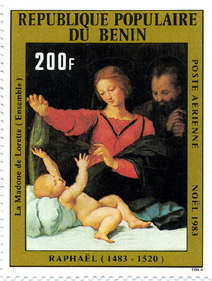
1513
Oil on wood
Loreto
Destined to Cardinal Riario, this painting--original or copy--in 1717 came into the possession of the sanctuary of Loreto. The theme is a very domestic one. Mary holds her veil or sash in playful gesture over the lying infant who is trying to catch it. The playfulness of mother and child is contrasted by the calm and meditative composure of St. Joseph standing to the right of mother and child.
Popular Republic of Benin, em.1983
42. Christ Carrying the Cross
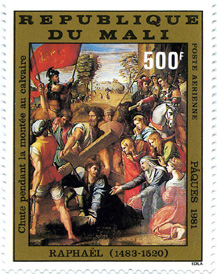
1517
Oil on canvas
318 x 230 cm
Prado, Madrid
Also called "spasimo" or spasm, the painting created for a church in Palermo shows Christ following beneath the Cross while the holy women are kneeling by and commiserating. The woman with outstretched arms and dramatic posture may well be his own mother. The painting was purchased by Philip IV, King of Spain. It may be a collective work of Raphael's studio.
Republic of Mali, em. 1981
43. The Small Holy Family
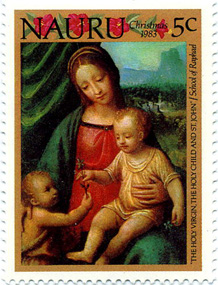
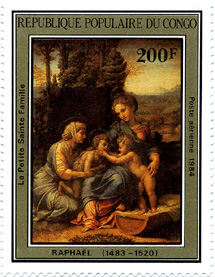
1518
Oil on wood
38 cm
Louvre, Paris
Among the smaller Holy Families such as the one of Naples (Nauru stamp, 1983), and the Madonna of Divine Love (1513), the one here featured shows the playful intimacy that reigns among the two children. Meanwhile, the mothers, the Virgin Mother and St. Elizabeth, are looking on in joyful pride. St. Joseph, again, fades into the background.
Popular Republic of Congo, em. 1984
Nauru, em. 1983
All About Mary includes a variety of content, much of which reflects the expertise, interpretations and opinions of the individual authors and not necessarily of the Marian Library or the University of Dayton. Please share feedback or suggestions with marianlibrary@udayton.edu.
